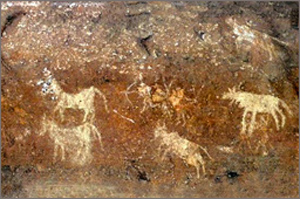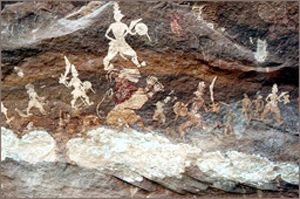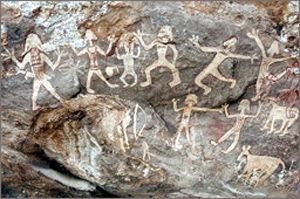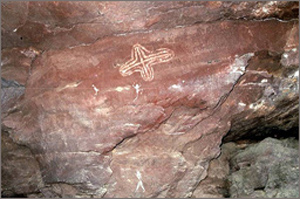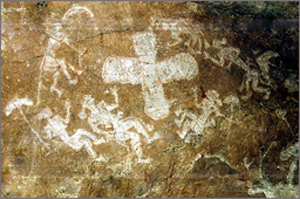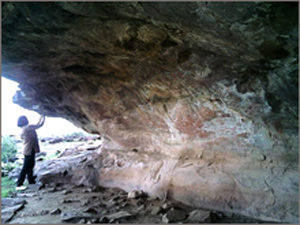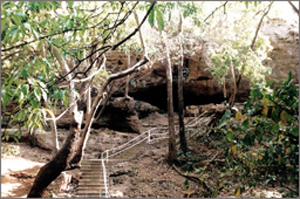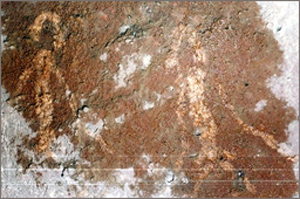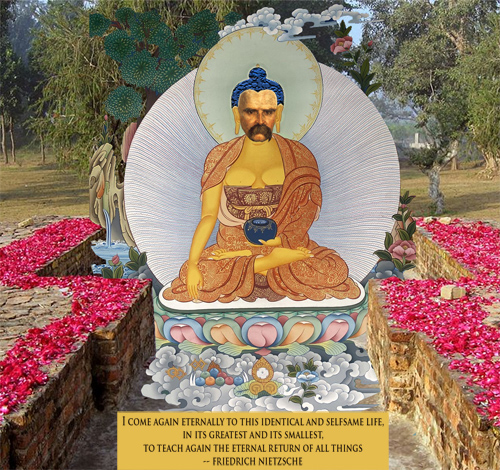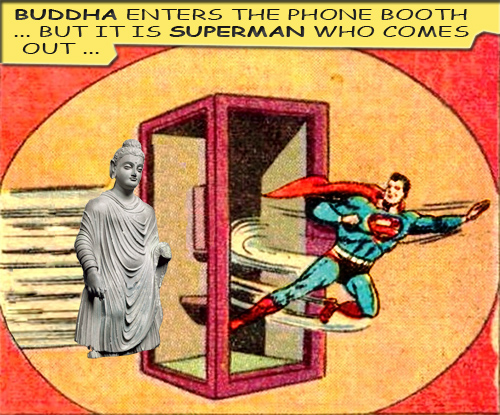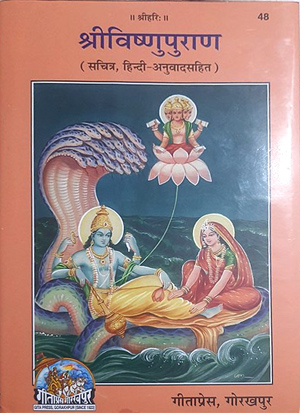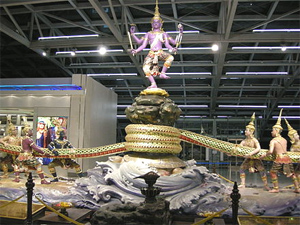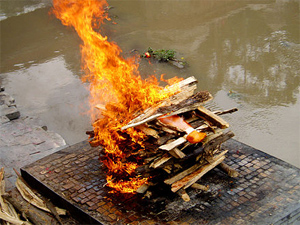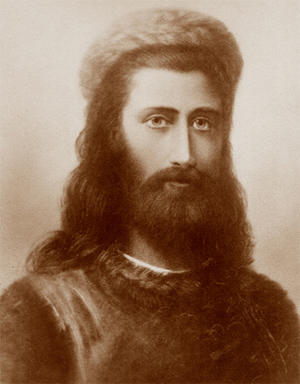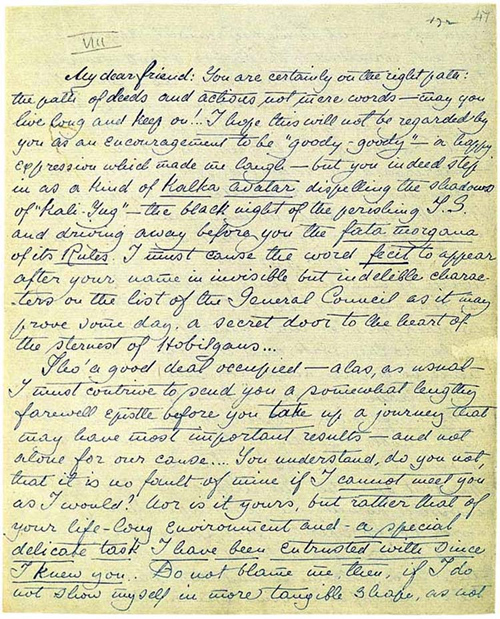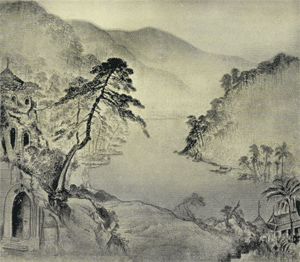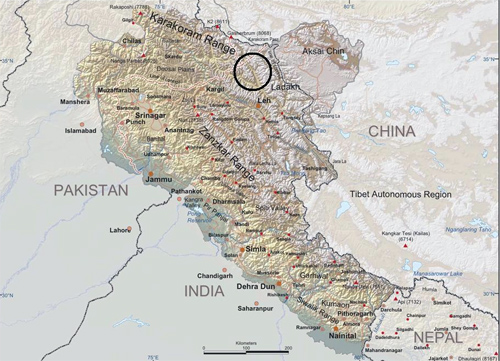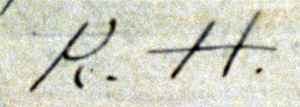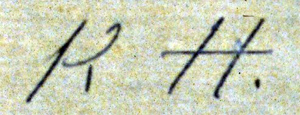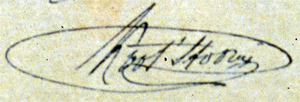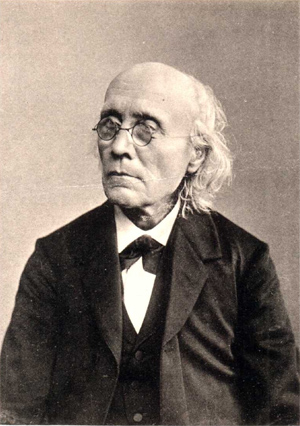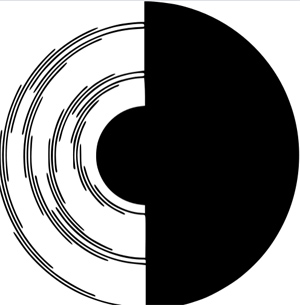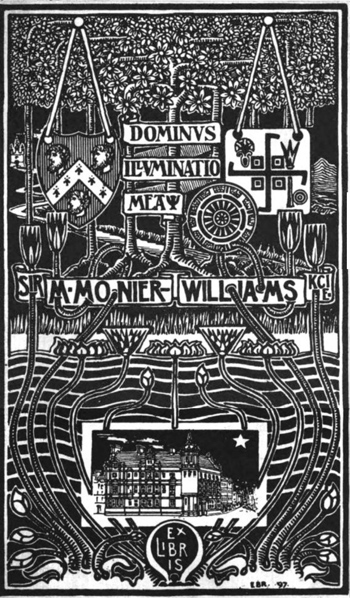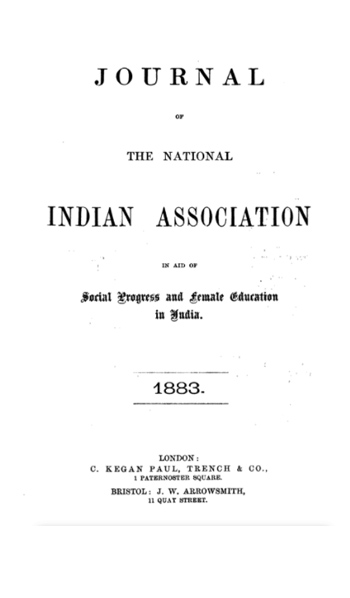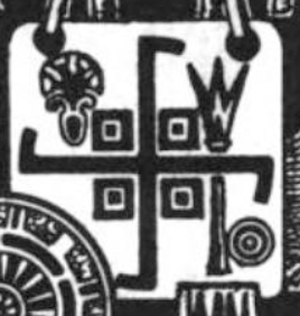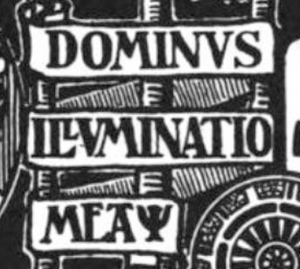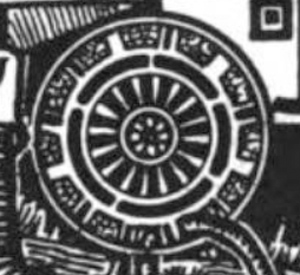by Charles and Tara Carreon
3/17/21
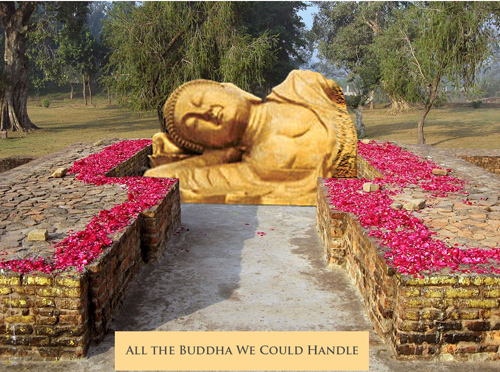
We are all familiar with the concept of the Procrustean Bed, that cross between hospitality and torture, wherein an individual is provided a bed smaller than necessary to accommodate his length, and is made to fit the furniture by amputation. As a child whose parents traveled often, I preferred to stay in high quality hotels for this reason. Alas, western society has not been so friendly to the faiths of foreign nations, that have been adapted to our local customs through drastic surgery of which we often remain blissfully unaware.
A case in point is the evolution of the "Cosmological Buddha," whose manifold personages cover the cave walls of a thousand devotional enclaves throughout Asia, into the "Historical Buddha," a humble fellow from just down the way who pulled his socks up, knows his prajna from his jnana, has no fear of death due to his serene view of life, and doesn't buy into this ego stuff, but is otherwise just like you and me. Now this sort of easygoing bloke is exactly the kind of guru I want, but I wager that a humble peasant praying for rain as opposed to famine, looking up at the enormous expanse of earth and sky up at the Himalayas to the north, would have no interest in following another fella. He wants an enormous Being, bigger than the sky, stronger than the wind, able to cool the heat of the sun, able to stop hail, bring rain, nurture life. Managing his mental dusty bunnies? Not actually on his list of things to do today. He's got clods to break, seeds to sow, seedlings to attend to, animals to feed, and no time for silly nonsense that the rich might be interested in.
But we have none of those problems. We are plagued by mental dust bunnies, loneliness, a society inclined to homicidal solutions, the fear of homelessness and abandonment. And the soil can't help us, the wind and the rain and stars are just window dressing for our misery. Maybe when climate change has reduced our pride a little, we'll need real gods again. Meanwhile, we can get by with pop Buddhism, which you might just call a "head trip."
Notes:
1. Jetavana, by Wikipedia
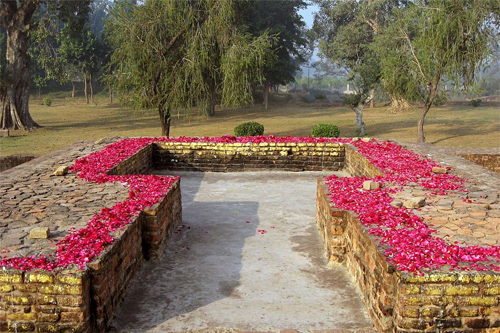
Mulagandhakuti. The remains of Buddha's hut in Jetavana Monastery.
2. The Buddha and Dr. Fuhrer: An Archaeological Scandal, by Charles Allen
On 2 February 1898 — that is to say, when Fuhrer was still deeply entrenched in his main dig at Sagarwa — the Government of Burma wrote to the Government of the NWP&O concerning complaints it had received from a monk named U Ma. These involved a certain Dr. A. A. Fuhrer, Archaeological Surveyor to the Government of the NWP&O. Shin U Ma had first taken the complaints to a local government official in Burma, Brian Houghton, and had then backed them up with tangible evidence in the form of letters received from Dr. Fuhrer. Houghton had duly passed U Ma's complaints and copies of his letters on to government headquarters in Rangoon, as a consequence of which they arrived on the desk of the Chief Secretary to the Government of the NWP&O, who passed them on to the Secretary of the Department of Revenue and Agriculture, Archaeology and Epigraphy. From there they made their way to the desk of the Commissioner of Lucknow.
As soon as he returned to his offices at the Lucknow Museum in early March Fuhrer was confronted with the communication from Burma and asked to explain himself. According to the file, his letters to the Burmese monk went back as far as September 1896, when he had written to U Ma about some Buddhist relics he had sent him, allegedly obtained from Sravasti. The contents of this first letter indicate that the two had met while the Burmese was on a pilgrimage to the holy sites in India and had struck up a friendship not unlike that described by Rudyard Kipling in his novel Kim (then in the process of being written in England), which begins with a wandering Tibetan lama being greatly moved by the knowledge of Buddhism shown by the Curator of the Lahore Museum (Rudyard's father J. L. Kipling).
Dr. Fuhrer and U Ma had then come to some arrangement for the one to send the other further relics. On 19 November 1896 Fuhrer wrote again to U Ma to say that:
The relics of Tathagata [Sakyamuni Buddha] sent off yesterday were found in the stupa erected by the Sakyas at Kapilavatthu over the corporeal relics (saririka-dhatus) of the Lord. These relics were found by me during an excavation of 1886, and are placed in the same relic caskets of soapstone in which they were found. The four votive tablets of Buddha surrounded the relic casket. The ancient inscription found on the spot with the relics will follow, as I wish to prepare a transcript and translation of the same for you.
This letter of 19 November 1896 was written more than a year after Fuhrer's first trip into Nepal made in March 1895 (during which he made his discovery of the Asokan inscription on the stump at Nigliva Sagar), but just before he set out on his second foray into Nepal (where he would meet up with General Khadga Shumsher Rana at Paderiya on 1 December 1896). Yet already, it seems, he had found Kapilavastu. In the year referred to in his letter — 1886 — he was still a relative newcomer to the NWP&O Archaeological Department and had yet to conduct his first excavation.
Fuhrer's next letter to U Ma was dated 6 March 1897, three months after his much trumpeted Lumbini and Kapilavastu discoveries. In it he referred to more Buddha relics in his keeping which he would hold on to until U Ma returned to India. Seven weeks later, on 23 June, there was a first reference to a 'tooth relic of Lord Buddha', and five weeks on, on 28 August, a further reference to 'a real and authentic tooth relic of the Buddha Bhagavat [Teacher, thus Sakyamuni]' that he was about to post to U Ma.
The letters now began to come thick and fast. On 21 September Dr. Fuhrer despatched 'a molar tooth of Lord Buddha Gaudama Sakyamuni ... found by me in a stupa erected at Kapilavatthu, where King Suddhodana lived. That it is genuine there can be no doubt.' The tooth was followed on 30 September by an Asokan inscription Fuhrer claimed to have found at Sravasti. Then on 13 December Fuhrer wrote to say that he was now encamped at Kapilavastu, in the Nepal Tarai, where he had uncovered 'three relic caskets with dhatus [body relics] of the Lord Buddha Sakyamuni, adding that he would send these relics to U Ma at the end of March. What is most odd here is that on 13 December 1897 Fuhrer had not yet entered the Nepal Tarai, having been given strict instructions that he was not to do so until 20 December.
This bizarre hoaxing — for no element of financial fraud seems to have been involved — could not go on. The arrival in Burma of the Buddha's molar tooth seems to have been too much for the hitherto credulous Burmese monk, who soon afterwards wrote what sounds like a very angry letter protesting at the remarkable size of the tooth in question. This letter was evidently forwarded from Lucknow to Basti and then probably carried by mail runner to Fuhrer's 'Camp Kapilavastu' at Sagarwa. It was replied to on 16 February 1898, when the Archaeological Surveyor was still encamped at Sagarwa. Writing at some length, Fuhrer went to great pains to mollify the Burmese, declaring that he could quite understand why 'the Buddhadanta [Buddha relic] that I sent you a short while ago is looked upon with suspicion by non-Buddhists, as it is quite different from any ordinary human tooth' — as indeed it was, since it was most probably a horse's tooth — 'But you will know that Bhagavat Buddha was no ordinary being, as he was 18 cubits in height [27' @ 18"/cubit; 48' @ 32"/cubit] as your sacred writings state. His teeth would therefore not have been shaped like others: In a further bid to shore up the credibility of the tooth, Fuhrer went on to say that he would send U Ma —
an ancient inscription that was found by me along with the tooth. It says, 'This sacred tooth relic of Lord Buddha is the gift of Upagupta.' As you know, Upagupta was the teacher of Asoka, the great Buddhist emperor of India. In Asoka's time, about 250 BC, this identical tooth was believed to be a relic of the Buddha Sakyamuni. My own opinion is that the tooth in question is a genuine relic of Buddha.
This supposed Asokan inscription was afterwards found to be written in perfectly accurate Brahmi Prakrit, its most obvious models being the many similar relic inscriptions found at Sanchi and other Buddhist sites, with which Fuhrer was very familiar through his work on Epigraphia Indica.
3. One Buddha, 15 Buddhas, 1,000 Buddhas, by Richard Salomon
Now I'll come to the main point, context and significance of the Library of Congress scroll. What's it about? Well, I call the "Many Buddhas Sutra." I would describe it as a combined comparative biographical summary of the lives of 15 Buddhas beginning with Dipankara, who lived many billions of years ago, and ending with Sakyamuni or Siddharta or "our Buddha" as he's sometimes called. And then going on one more to Maitreya or Ajita who is the next Buddha. So those 14 Buddhas in the past and one Buddha in the future. So these are the 15 Buddhas involved. Start with Dipankara. Number 14 is Sakyamuni who actually is Sakyamuni the second, surprisingly. And then on to Maitreya in the future...
There's another related text which contains these lists of buddhas and their times and their characteristics. It's called the Bhadrakalpikasutra. Some of you might be familiar with it. And Bhadrakalpika means it talks about the bhadrakalpa, kalpa means eon. And it's a list of buddhas but not from the past but looking ahead in the future. So it actually starts with the first Buddha in the bhadrakalpa that is Kakusandha and goes through Sakyamuni, our Buddha, and Maitreya and then 996 more buddhas are still to come within this Bhadra era. ... So at this point, you might be wondering the text that I'm primarily concerned with contains 15 buddhas. I mentioned another one that enumerates 1001 buddhas and there are many other numbers. There's a famous early sutra, the [inaudible] sutra, which has seven buddhas which seems to be the original number. There's another polytext called Buddhavamsa which lists 25 buddhas. And significantly in that case, it lists 25 buddhas but it begins with Dipankara and that's particularly an important moment within the history of the buddhas plural, Dipankara has a special importance which I will explain in a few minutes. Just I'll mention one other number, the Mahavastu which is a Sanskrit biography of the Buddha, also has a list of buddhas. It has a long list, 331,140,263 buddhas from the remote inconceivable past down to the present time of Sakyamuni...
So how many buddhas are there? I finally come back to the question. Infinite number. Why infinite? Because time is infinite in the Buddhas conception both in the past and the future. There is no beginning. There is no end. And throughout history, buddhas are either present or most of the time in the process of forming at some time. And that's why the Mahavastu can say in all seriousness that there are 331 million et cetera buddhas. There're actually much more than that. There are an infinite number. But these different texts or these different presentations, usually by the Buddha himself, simply address the issue or explain the issue in a limited scope because you can't, well the Buddha can talk about, understand eternity but we can't. So it takes -- These different texts are really slices of history, slices of Buddha history, which is infinite from beginning to end. Some of them talk about the recent past. Some of them talk about a little farther in the past. Some go into the future. Some are concerned mainly with the future. But they're all just pieces of the big picture. I call them slices of history...
In the list of 15, there's Sakyamuni the first and of course it doesn't say the first. I just put together those numbers. He was number eight. I don't know. I'm not sure. And then Sakyamuni the second. But there's another point about that which I didn't mention. I talked about that list in the Mahavastu of 331,140,263 buddhas. What I didn't say is that out of the 300 million, out of the 331, 300 million were named Sakyamuni. And according to that text, there was a stretch of 30 million buddhas in a row that were all had the same name. And I have thought about and failed to understand what that, why that is and what that means. But there is -- You know, buddhas are and by impression, they're more or less the same and their images, I don't think I have one here, but you see in Gandhari and other sculptures, you see sets of buddhas like the seven buddhas or sometimes eight buddhas and they're all almost exactly the same. So there seems to be a range of possibilities that buddhas are always similar and they can be very similar and sometimes they are absolutely identical.

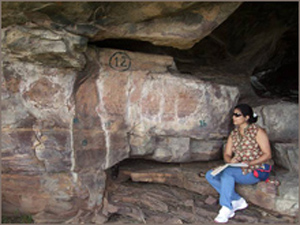
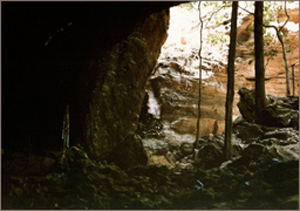
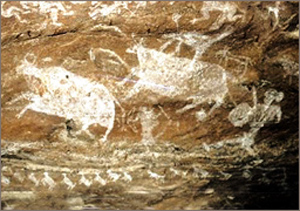
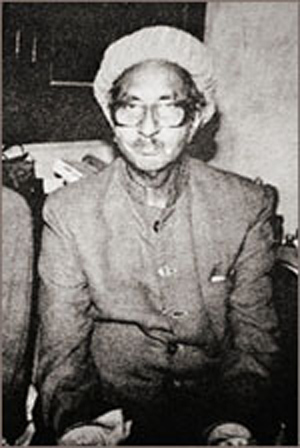
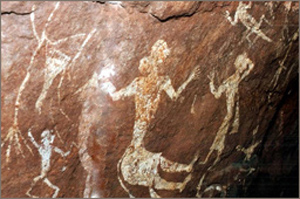
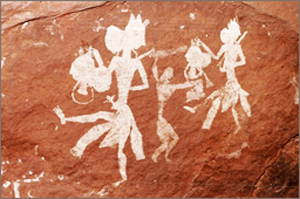
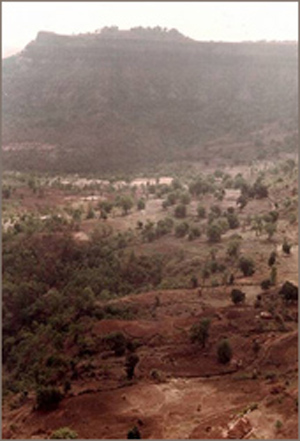
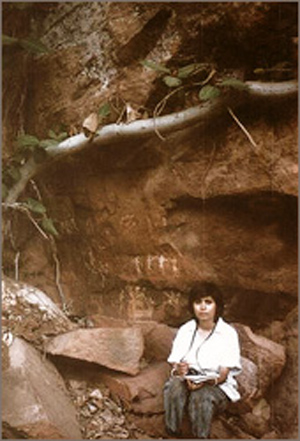
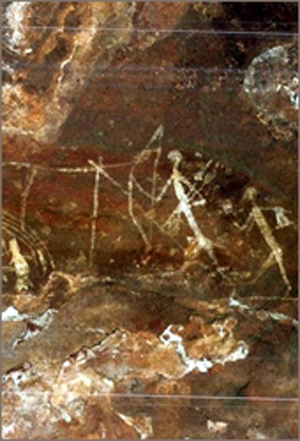
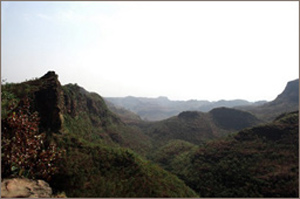
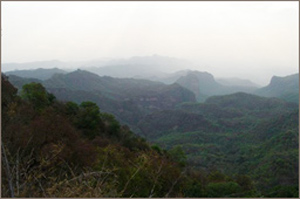
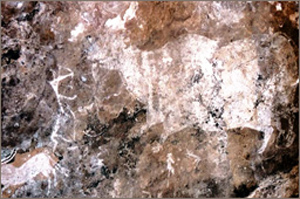
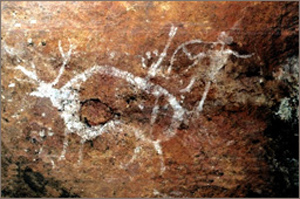
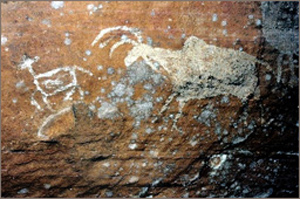
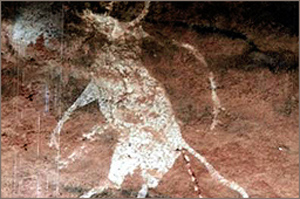
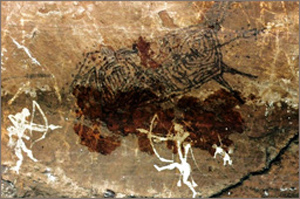
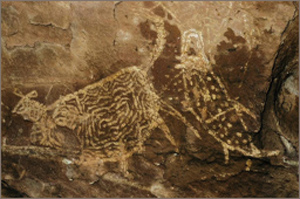
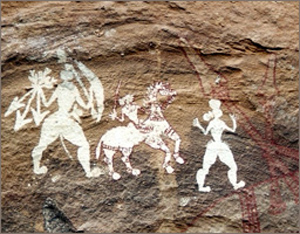
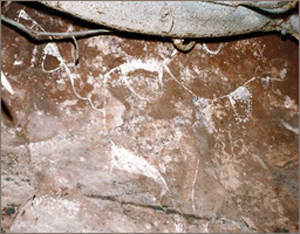
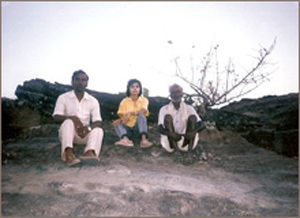
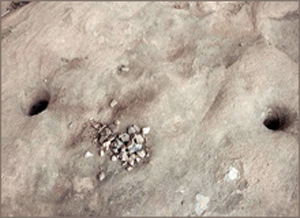
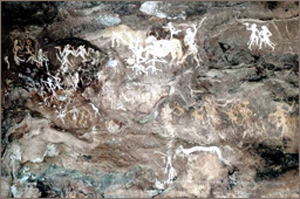
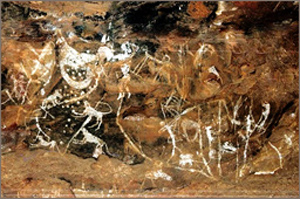
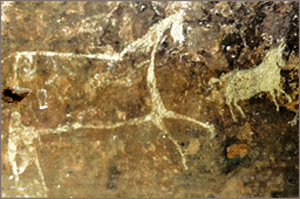
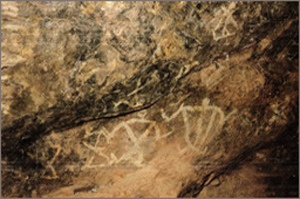
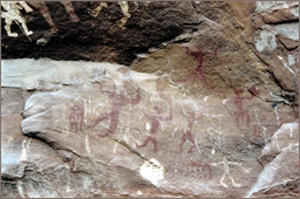
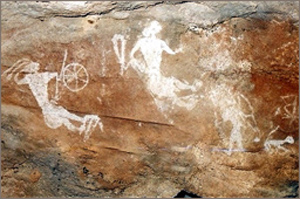
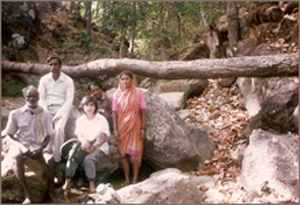
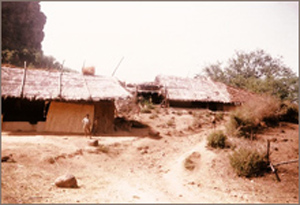
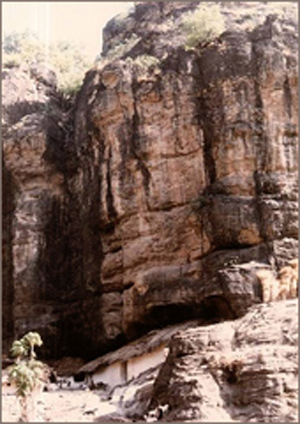
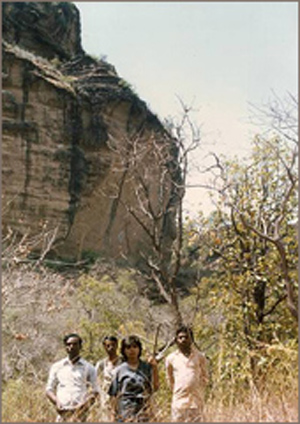
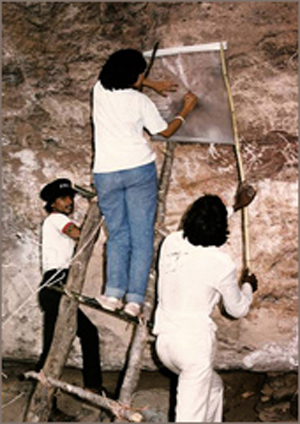
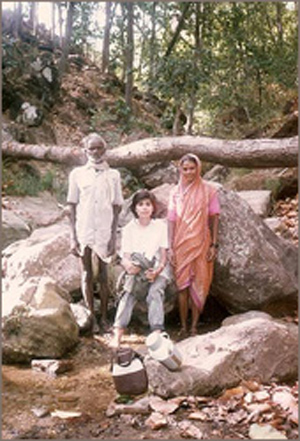
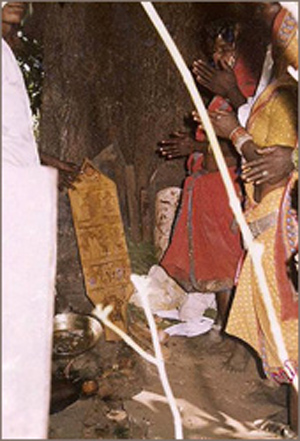
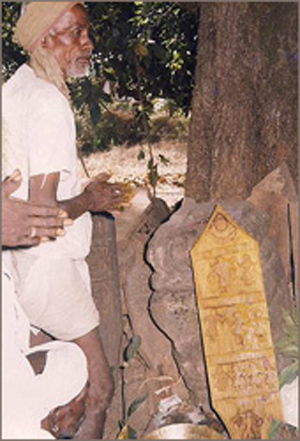
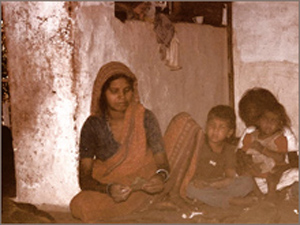
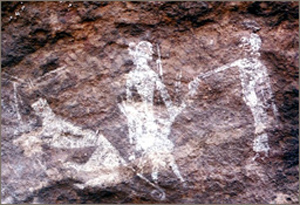
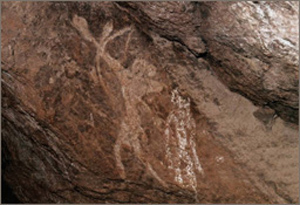
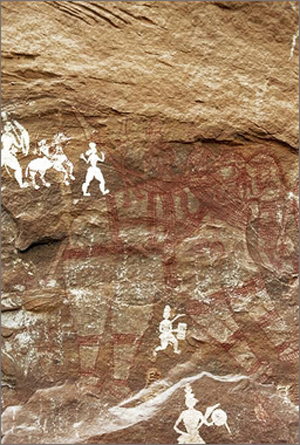
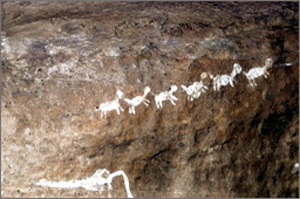
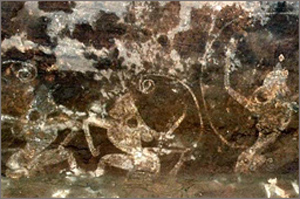
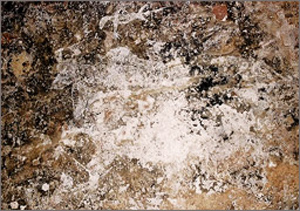
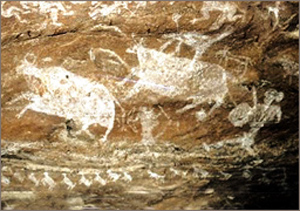
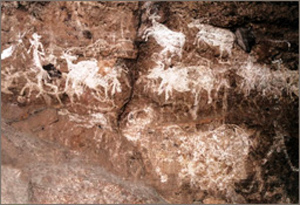
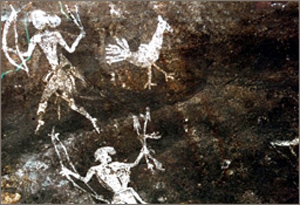
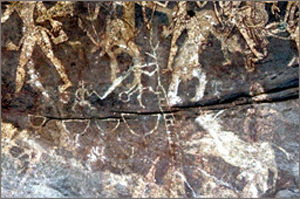
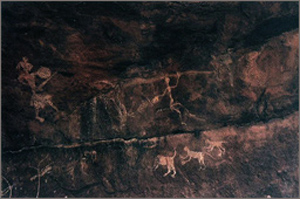
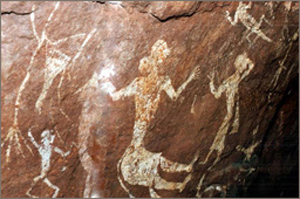
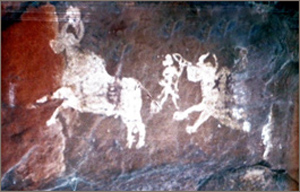
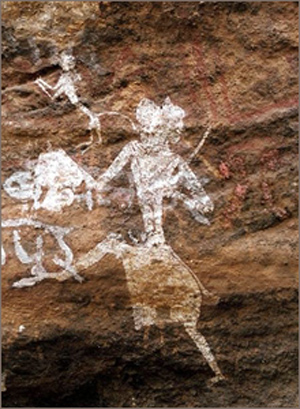
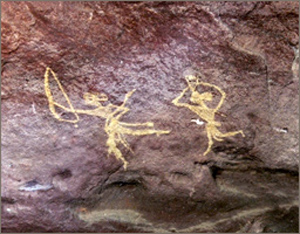

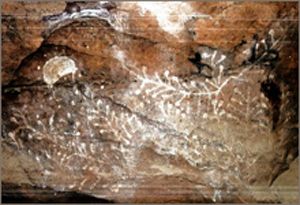
 x]
x]